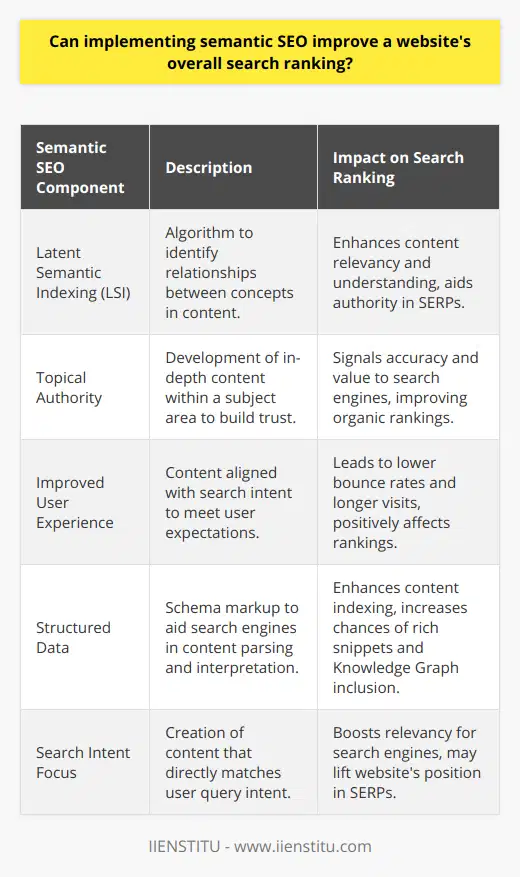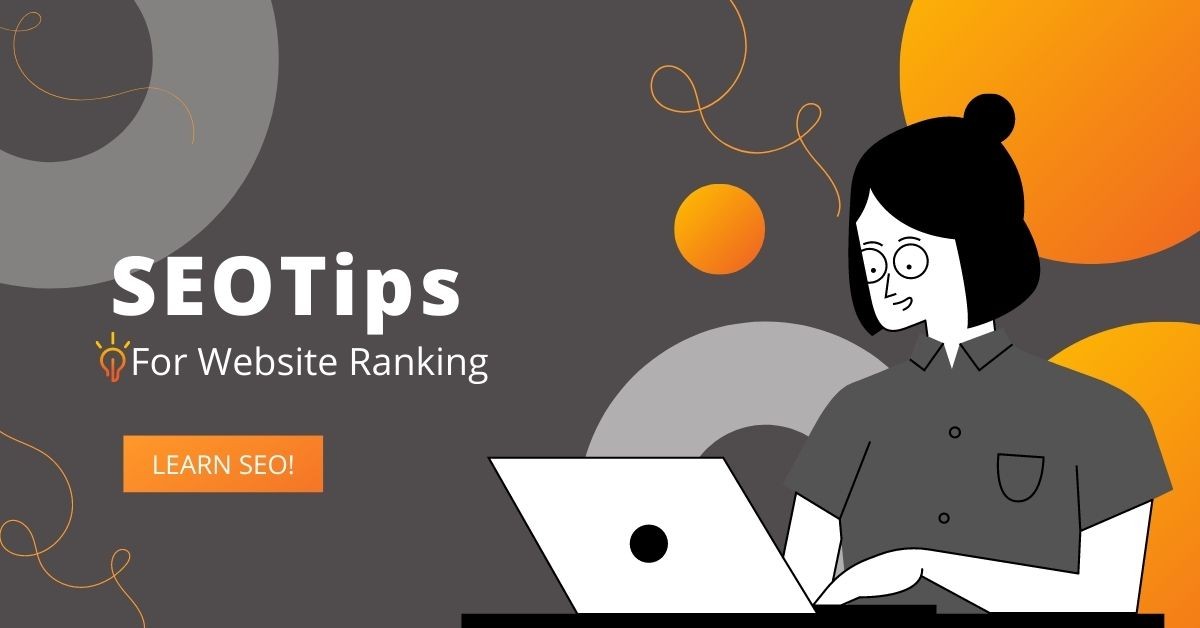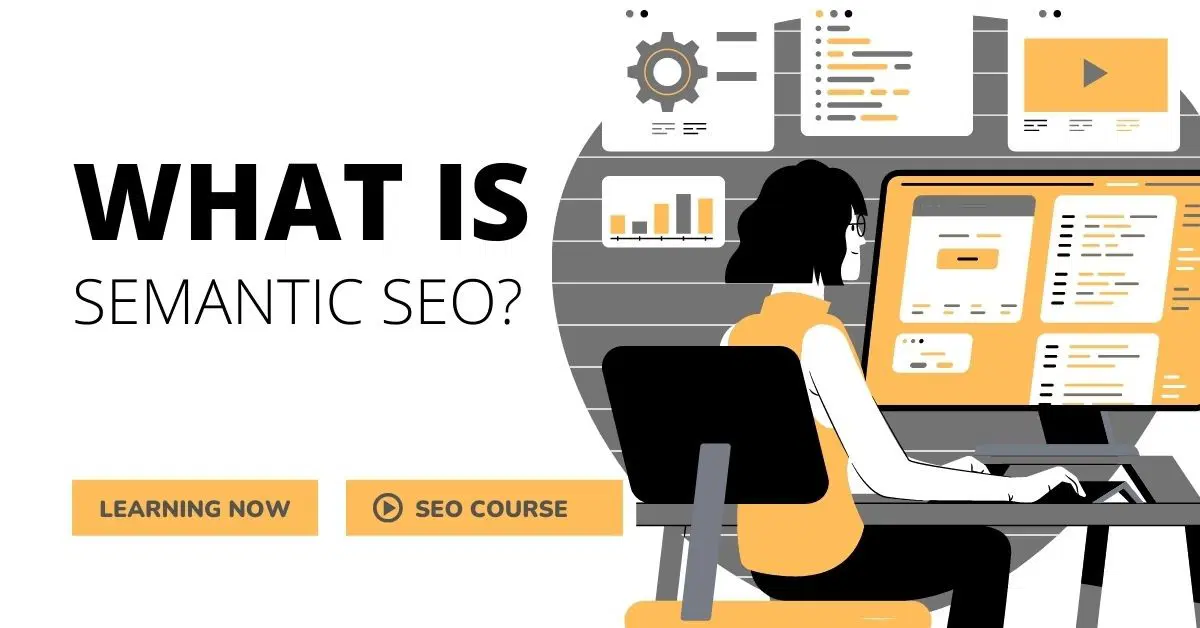
Semantic SEO is a way to make the search engine understand what you're trying to say. This means that when people use their keywords in content, they will be given more leverage and visibility on SERPs (searched images results).
The semantical Search Engine Optimization process starts by using keyword tags or key phrases throughout your website's pages so Google can properly analyze them - which leads us to our next point.
And also, in this blog, we handle these frequently asked questions on different topics. You can clearly understand these five topics;
What is semantic SEO?
What are the benefits of semantic SEO?
How can semantic SEO help my website?
Why is semantic SEO essential for websites?
How to implement semantic SEO on a website?
What Is Semantic SEO?
Semantic SEO involves organizing your content, so search engines better understand what it means, how it pertains to other relevant information online, and what topics you cover to return accurate results for user queries when looking for a specific material, e.g., "best iPhone apps." Without SEO tags appropriately structured, SEO can be more complex, and the SEO strategy may need to shift toward SEO optimization for specific keywords. However, having at least basic SEO on your posts will still help you get traffic from SEOs if you're not focused solely on SEO-optimized content.
Before we get started with SEO tags, keep in mind that while there are some basic SEO best practices that everyone should follow when it comes to SEO and blogging, there is no one size fits all SEO formula because every blog and website is different. The search engines update their ranking algorithms regularly, so what worked last year might not work this year, even though it still holds for most blogs or websites. In addition, every blog has different topics and focuses, so take SEO tips with a grain of salt and test SEO strategies for yourself to find what SEO techniques work best for your blog.
How Do I Use Semantic SEO?
To use Semantic SEO on your website, you'll need to start by adding keyword tags or key phrases to your content. You can do this by using a tool like Google AdWords, Keyword Planner to help you find popular keywords related to your topic.
Once you've selected your keywords, you'll need to add them to your website's content in a way that makes sense to both humans and search engines. You can do this by using them in the title of your page, in the body of your content, and in the metadata of your page.
It's also essential to ensure that your website is optimized correctly for mobile devices. In addition to adding keyword tags and optimizing for mobile, you'll also need to make sure that your website is fast and easy to use.
What Are The Benefits Of Semantic SEO?
The benefits of Semantic SEO are vast and include better visibility on SERPs, increased website traffic, and improved user experience. In addition, by using keyword tags and optimizing your website for mobile devices, you can improve your website's ranking on search engines, which will result in more people visiting your site.
In addition to increased website traffic, Semantic SEO can also lead to better user engagement. By ensuring that your website is easy to use and fast-loading, you can ensure that your visitors have a positive experience while browsing your site. This, in turn, can lead to more conversions and sales.
How To Optimize A Website With Semantic SEO?
Let’s focus on how to optimize your website with semantic SEO. This is important!
Additionally suggestion: You can learn this with courses. Maybe you can join the SEO course at the institute, I mean at IIENSTITU. It’ll be beneficial for you.
Keyword Research
The SEO tags you use can help search engines locate your content more quickly, so it will rank higher in the SERPs. However, there are times when SEO is still tricky and isn't an exact science because not all SEO tags or SEO optimization practices explained below will work for every website and every use. Also, please note that while basic SEO is essential, we're going to get into some advanced SEO stuff here, so if this is too much information, just stay on top of basic SEO by making sure you include the keywords you want to target in your title tag, SEO description, SEO Keywords tag and within has your focus keyword 5 to 10 times.
Search Engines
Also, note that search engines are constantly evolving, so SEO is changing. Google has introduced many SEO changes over the years because SEO now crawls websites to see what content exists and analyzes a website's user experience based on page loading speed, mobile-friendliness, user engagement signals (social media), and time on site. For example, if you have a high bounce rate or low average time spent on your blog posts – SEO may consider your blog content poor quality and therefore less important for ranking. Also, SEO will determine how well a piece of content is performing on social media and whether to push it up in SEO’s SERPs.
Content Organization
SEO tags help SEO determine how your content is organized, what words you use to describe the SEO descriptions and keywords of each piece of SEO copy and SEO optimized images, and how well it relates to other content parts online. For example – SEO will look at links between pieces of content – if one blog post links back to another older work of SEO copy – this signals that this SEO copy is more relevant or essential than SEO copy that doesn't link out. It also signals that the author considers the other SEO copy as having a high level of importance because they're willing to link to it. SEO tags that focus on SEO copy, SEO descriptions, and SEO-optimized images may help SEO find your content more quickly than SEO did before, so keep this in mind when optimizing SEO tags and updating SEO copy.
SEO Tags for Social Media
SEO will look at social media signals such as Facebook likes, Twitter followers, Google shares, Pinterest pins, and other signs to determine how well a piece of content is performing on social media. I.e., if many people are sharing a blog post on Twitter, it must be very relevant or essential regardless of how many SEO keywords it contains. To make SEO aware of social media signals, you want SEO tags that include SEO copy, SEO, and your SEO optimized images with their respective SEO descriptions. Also, make sure the Facebook-like button is configured correctly, or SEO will ignore it because they won't understand what users like when they click on this button.
SEO Tags for Local Search
Your SEO keywords should be included in your SEO title tag (if you're doing business SEO but) also make use of the geo-specific search features offered by Google Maps to improve local listing optimization – choose categories wisely, write accurate business descriptions, upload high-quality photos and include detailed contact information including hours if applicable. Like other types of SEO optimization, SEO will look at SEO title tags and SEO descriptions in the same way it seems at Facebook, like shares, +1s, and tweets, so make sure you include SEO keywords in these texts.
SEO Tags for Image Search
The SEO copy tag is significant when optimizing your images because SEO pays close attention to this tag, so they know what your vision is about. Also, use descriptive SEO-optimized photos with captions that describe what users can expect to see when they click on an image. Be sure to specify which version of Photoshop or Gimp was used when creating the file (including the specific version number) so search engines can display accurate results when people perform searches based on these programs. Finally, don't stuff SEO keywords into your SEO tags. SEO will see right through this and just ignore it.
SEO Tags for Videos and Video SEO
Your SEO keywords should be included in your SEO title tag (if the video has a specific business name). Use SEO-optimized images with descriptions to describe what users can expect to learn when clicking on the video thumbnail. This is more important than many people think, so don't forget about these SEO tags, or you won't get the rankings you deserve. If applicable, don't forget to submit your video to video sharing sites like YouTube because this is another form of social media thatSEO look at while doing their job.
Last, of all, Semantic SEO is a powerful tool that can help you improve your website's visibility on search engines and boost your online traffic. By adding keyword tags to your content and optimizing your website for mobile devices, you can improve your website's ranking on search engines, which will result in more people visiting your site.
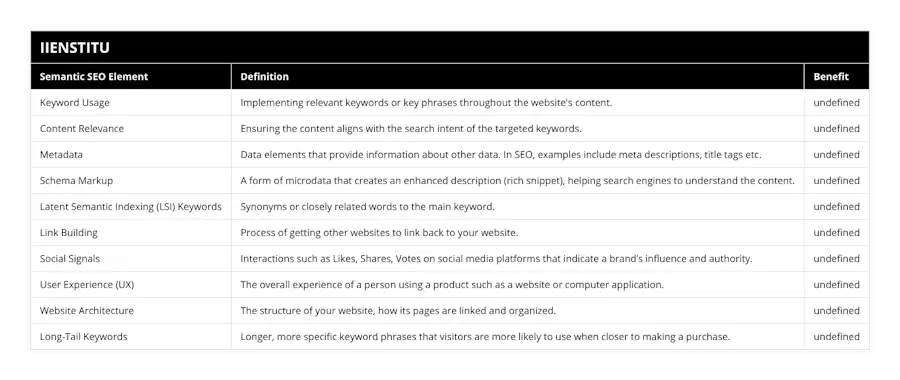
Frequently Asked Questions
What is semantic SEO?
Semantic SEO is the process of organizing your content, so search engines can better understand what it means and how it pertains to other relevant information online.

What are the benefits of Semantic SEO?
Semantic SEO leads to better visibility, increased website traffic and improved user experience.
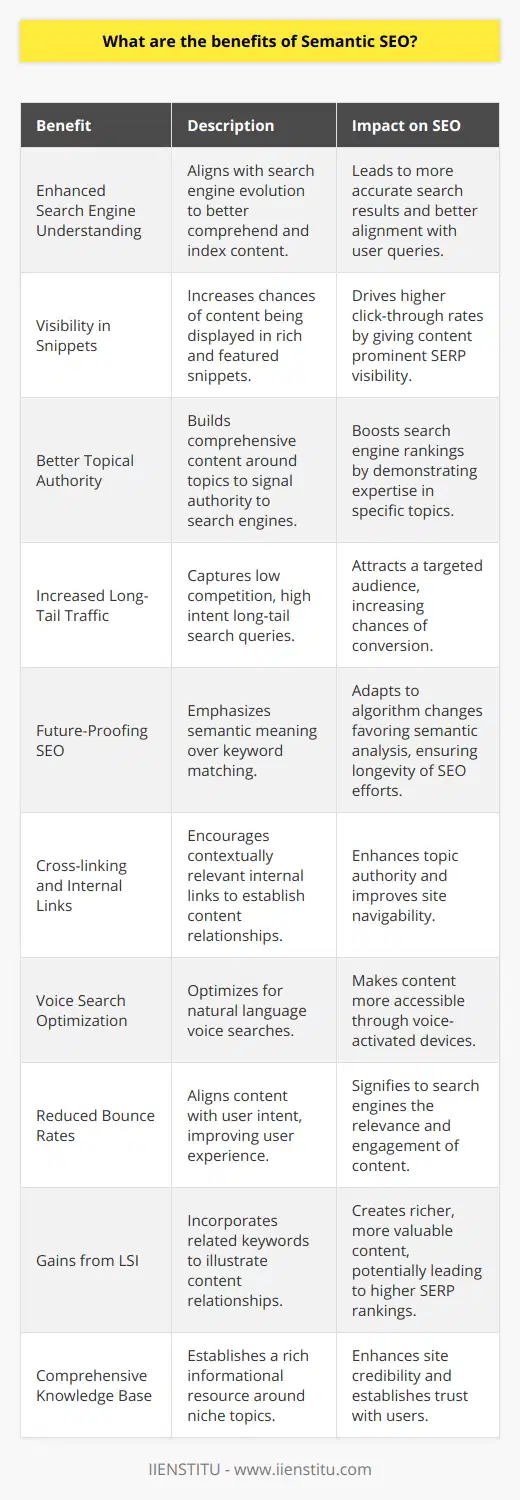
How to Optimize a Website with Semantic SEO?
Semantic SEO helps you optimize your website for mobile devices by adding keyword tags to content and increasing the rank on search engines, which will result in more traffic.
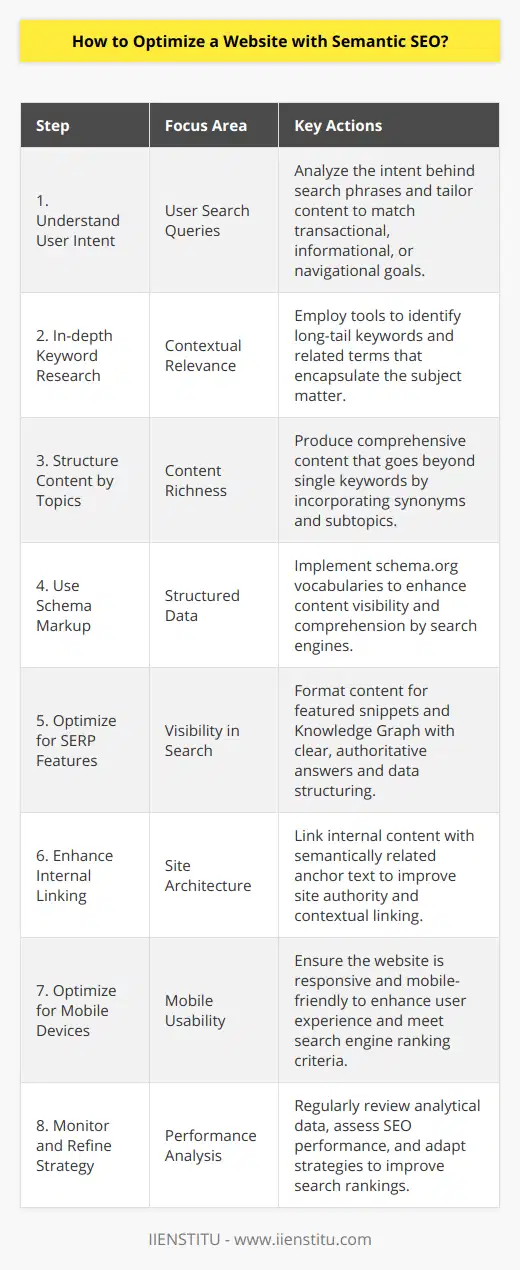
What is the difference between SEO and semantic SEO?
Semantic SEO: Enhanced Meaning and Context
The primary difference between traditional Search Engine Optimization (SEO) and Semantic SEO lies in their approach to enhancing a website's ranking on search engine results pages. Traditional SEO focuses on optimizing keywords and metadata, while Semantic SEO concentrates on improving the meaning and context of web content to facilitate a better understanding by search engines.
Traditional SEO: Keyword-based Approach
Classical SEO strategies revolve around keyword research, optimization, and link building. The aim is to increase the website's visibility by focusing on a few defined keywords relevant to the target audience. However, dependency on keywords has its limitations, as it may lead to an overemphasis on specific words or phrases and neglect the overall content's context and quality.
Semantic SEO: Contextual Understanding
Semantic SEO, however, goes beyond mere keyword optimization. It aims to enhance the content's meaning and structure using structured data markup (such as Schema.org), which helps search engines better understand the context of a webpage. This enables the search engines to provide more accurate and relevant search results, leading to improved user experience and higher click-through rates.
Role of Artificial Intelligence in Semantic SEO
With the advancement of artificial intelligence, search engine algorithms have evolved to recognize the context, sentiment, and user intent behind the search queries. By incorporating deep learning techniques, search engines like Google can now analyze unstructured data and identify patterns, relationships, and meanings within the content. This shift from keyword-driven to context-driven search results has made semantic SEO a critical aspect of modern digital marketing.
Content Quality and User Experience
Semantic SEO stresses the importance of creating high-quality content that is well-written, relevant, and valuable to the target audience. Delivering a positive user experience through easy navigation, optimized page load times, and mobile-friendly design also plays an essential role in semantic SEO strategy, as these elements contribute to improved user engagement, which search engines consider while ranking the webpages.
In conclusion, semantic SEO represents an evolution in search engine optimization techniques. By focusing on the meaning, context, and structural aspects of web content, it overcomes the limitations of traditional keyword-based SEO and upholds content quality and user experience as key aspects of achieving better search engine rankings.
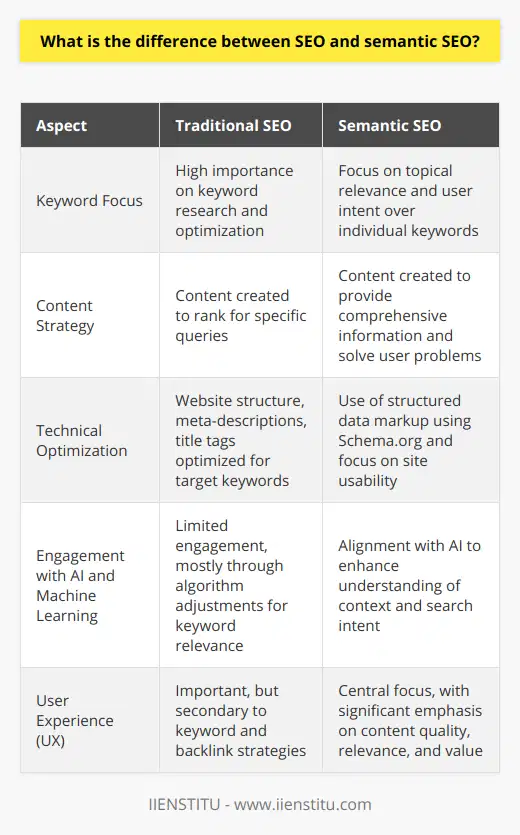
What is semantic search and why does it matter for SEO?
Understanding Semantic Search
Semantic search refers to the process through which search engines analyze the context and intent behind users' queries to present more relevant and personalized results. Unlike traditional keyword-based search approaches, semantic search leverages artificial intelligence (AI) and natural language processing (NLP) to understand the meaning and relationships between words and phrases.
Significance in SEO
In recent years, semantic search has gained significance in search engine optimization (SEO) as search engines have evolved to focus on user experience and satisfaction. This shift requires businesses to not only optimize their content for specific keywords but also ensure that it aligns with users' queries and needs.
User Intent and Query Context
In semantic search, understanding user intent and query context is critical, as it allows search engines to deliver results that better match user expectations. This means that businesses should create content that addresses users' needs and answers their questions, rather than merely focusing on keyword placement and density.
Latent Semantic Indexing
One relevant aspect of semantic search is latent semantic indexing (LSI), a mathematical technique that identifies relationships between terms and concepts in a given set of documents. By incorporating LSI into an SEO strategy, content creators can improve their site's visibility and relevance to users with related queries, thus driving more organic traffic.
Semantic Markup
Another vital component of semantic search is the implementation of structured data or semantic markup on websites. By using schema.org markup, businesses can provide search engines with additional information about their content, facilitating better content interpretation and enhancing search result snippets with rich features, such as ratings, prices, and event details.
Entity Recognition
Semantic search also involves identifying entities in user queries – critical components like names, places, and concepts – and presenting relevant results based on these entities. For businesses, optimizing content to include prominent entities can lead to improved search engine rankings and enhance their content's overall discoverability.
Conclusion
Semantic search plays a crucial role in modern SEO strategies due to its focus on user intent and context, which ultimately creates a better user experience. By understanding and addressing semantic search's various components, businesses can improve their online visibility, drive more organic traffic to their websites, and strengthen their positioning in a competitive digital landscape.
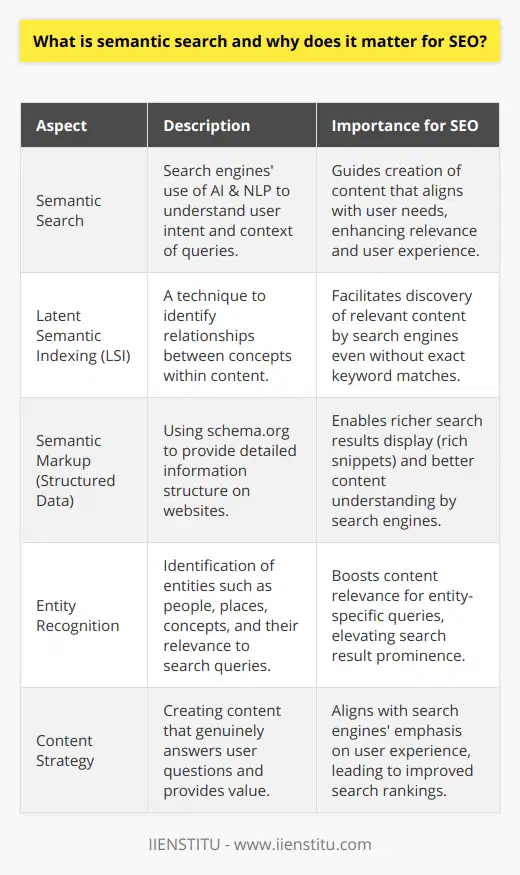
What is semantic keyword search?
Understanding Semantic Keyword Search
Semantic keyword search refers to a method of searching for information on the internet that focuses on understanding the context and meaning behind search terms. This approach works by analyzing the relationships between words and phrases in a query, allowing search engines to provide more accurate and relevant results for users.
The Role of Context
In semantic search, context plays a vital role in understanding the true intent of a user's query. By taking into account additional information, such as user location and search history, search engines can better decipher the meaning behind search terms and provide more relevant results.
Natural Language Processing
Underlying the process of semantic search is the use of natural language processing (NLP) algorithms that enable search engines to understand human language more effectively. NLP allows search engines to analyze and interpret the relationships between different words and phrases in a user's query, making it possible to deliver more accurate search results.
The Importance of Latent Semantic Indexing
A crucial aspect of semantic keyword search is latent semantic indexing (LSI), which is a mathematical method used to identify the hidden relationships between words in a dataset. LSI helps search engines to better understand the meaning and context of a user's search terms, leading to more accurate search results.
Benefits for Users and Content Creators
Semantic keyword search not only benefits users by providing more relevant and accurate search results, but it also benefits content creators. By focusing on the intent and meaning behind search terms, content creators can optimize their content for semantic search to attract more targeted traffic to their websites.
The Future of Semantic Keyword Search
As search engine algorithms continue to advance and improve their understanding of human language, semantic keyword search is expected to play an increasingly prominent role in providing users with more accurate, relevant, and useful search results. Content creators that adapt to these changes and optimize their content for semantic search will likely enjoy greater success in attracting targeted audiences to their websites.
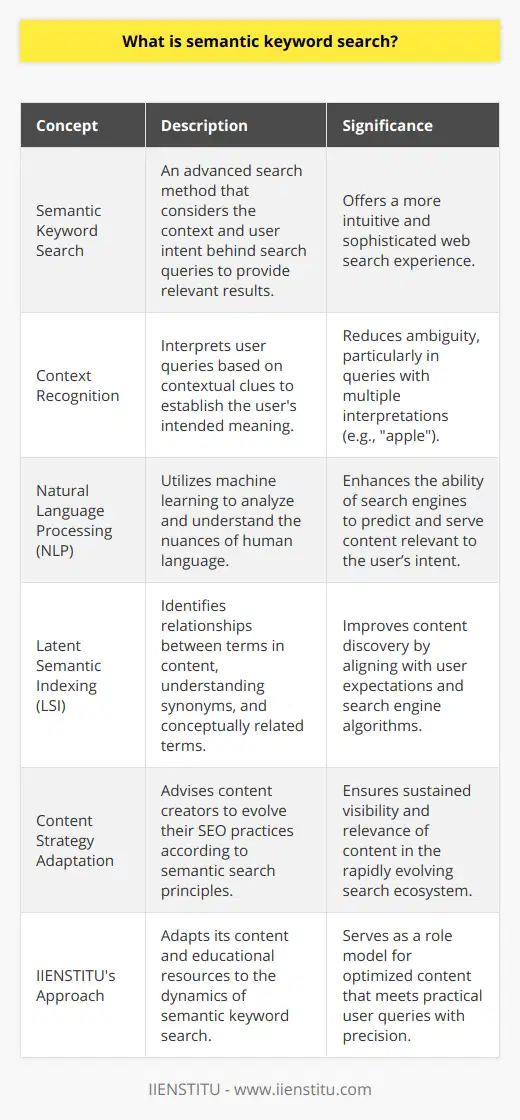
What is an example of semantic SEO?
Semantic SEO: An Illustration
Understanding Semantic SEO
Semantic SEO refers to the practice of optimizing a website's content precisely by focusing on the intended meaning behind user queries. With the continuous evolution of search engine algorithms, understanding the context and the users' intent has become crucial in crafting effective SEO strategies.
The Introduction of Hummingbird
A prime example of semantic SEO's importance can be observed with Google's implementation of the Hummingbird algorithm update in 2013. This update significantly improved Google's ability to discern the context and intention behind search queries, ensuring that search results are more relevant and useful for users.
How Latent Semantic Indexing Plays a Role
Latent Semantic Indexing (LSI) is a mathematical technique that helps search engines better understand the relationships between the various terms within a document. By analyzing the usage and co-occurrence of words, search engines can identify the central concepts discussed in a piece of content which aids in effective semantic SEO.
Accommodating Google's Knowledge Graph
Google's Knowledge Graph is another notable development in the world of semantic SEO. The Knowledge Graph strives to provide users with quick, accurate answers and relevant information by understanding the connections between different entities, concepts, and ideas. Content creators must ensure that their content is structured and optimized to fit into Google's Knowledge Graph framework.
Semantic SEO in Practice: A Blog Post
To implement semantic SEO in a blog post, content creators must first perform thorough keyword research. This involves identifying long-tail keywords and understanding user intent behind search queries. By creating content that naturally includes relevant keywords and addresses user intent, content creators can optimize their blog post for semantic SEO.
Conclusion
Semantic SEO plays an indispensable role in modern search engine optimization strategies. By understanding the context and user intent behind search queries, content creators can craft highly relevant, engaging, and informative content that effectively caters to user needs and optimizes their website's performance in search engine results.

How does semantic SEO enhance content relevance?
Subheading: Understanding Semantic SEO
Semantic SEO refers to the process of optimizing a website's content, making it more understandable and valuable for both humans and search engines. By using natural language processing and analyzing user intent, semantic SEO enhances the relevance of the content, providing users with more accurate, context-based information in SERPs (search engine results pages).
Subheading: Improve Content Relevance
The incorporation of semantic SEO increases content relevance by better capturing user intent and providing answers that specifically address their searched queries. Keyword research and analysis play a vital role in semantic SEO, as they help to identify terms and phrases that users employ when searching for specific information. By integrating highly targeted keywords that reflect user intent, content creators can improve the relevancy and value of their blog posts, resulting in a more satisfying user experience and increased website traffic.
Subheading: Enhance User Experience
One of the critical advantages of semantic SEO is the improvement of user experience on a website or a blog. By providing content that is highly relevant and focused on user intent, semantic SEO makes it easier for readers to find and consume the information they are looking for, which in turn increases visitor satisfaction and enhances the overall experience. Additionally, user engagement becomes more robust as the content resonates better with the target audience, leading to higher conversion rates for the website or blog.
Subheading: Boost Organic Traffic
When content relevance is improved and user experience enhanced, organic search traffic increases as well. Search engines like Google prioritize websites with high-quality, relevant content in their ranking algorithms. By utilizing semantic SEO techniques, content creators can make their blog posts more appealing to search engines, resulting in higher rankings and increased organic traffic. Ranking higher in SERPs also increases the likelihood that users will click on the link and visit the website or blog.
Subheading: Conclusion on Semantic SEO and Content Relevance
In conclusion, semantic SEO significantly impacts content relevance and the success of a blog post by focusing on user intent, increasing content value, and enhancing user experience. The resultant blog posts rank higher in search results and attract more organic traffic, increasing a website's visibility and boosting user engagement. Implementing semantic SEO strategies is an essential step for content creators seeking to provide relevant information that meets the needs of their audience, ultimately resulting in a successful and engaging blog.
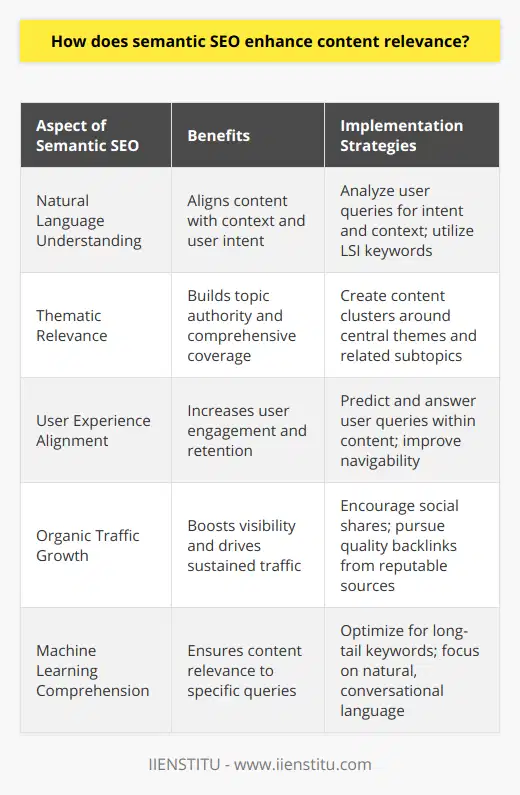
How can understanding the intent of search queries improve SEO strategies?
Impact on Content Development
Understanding the intent of search queries enhances SEO strategies by informing content development. When businesses comprehend the underlying goal a user intends to achieve by entering a specific query, they can tailor their content to fulfill that purpose. Consequently, meeting user expectations increases the probability of garnering organic traffic and high conversion rates.
Importance of Long-Tail Keywords
Another way that understanding search query intent impacts SEO strategy is by revealing the significance of long-tail keywords. These keywords typically convey specific needs or preferences, allowing businesses to identify niche markets and optimize their content accordingly. By targeting long-tail keywords, brands can enhance their visibility, drive more relevant traffic, and reduce competition from websites focusing on general or short-tail keywords.
Personalization in SEO Strategy
Furthermore, comprehending search query intent enables businesses to personalize their SEO strategies, as they can generate content that resonates with individual users. By addressing specific user questions, concerns, or desires, tailored content demonstrates a company’s understanding of its target audience, bolstering credibility and trustworthiness. Consequently, personalized content is more likely to produce higher user engagement and conversion rates, positively impacting a company's SEO.
Enhancing User Experience
Understanding search query intent is also crucial in enhancing user experience by presenting relevant and valuable content based on user needs. Ensuring that the material produced aligns with the searcher's intent minimizes bounce rates, as users will more likely remain on a website that addresses their inquiry. Ultimately, a satisfactory user experience is a crucial factor in attaining higher search engine rankings and staying ahead of competitors.
Optimizing Metadata for SEO
Lastly, recognizing search query intent allows for the optimization of metadata, such as title tags, meta descriptions, and header tags. These components play a vital role in attracting organic traffic, as they provide users and search engines with a brief overview of a webpage's content. By incorporating target keywords and reflecting user intent within metadata, companies can enhance visibility and click-through rates by appealing to both users and search engines.
In summary, understanding the intent of search queries significantly improves SEO strategies by informing content development, emphasizing long-tail keywords, personalizing SEO approaches, enhancing user experience, and optimizing metadata. By focusing on user needs and preferences, businesses can develop a robust online presence, attract relevant traffic, and increase conversion rates.
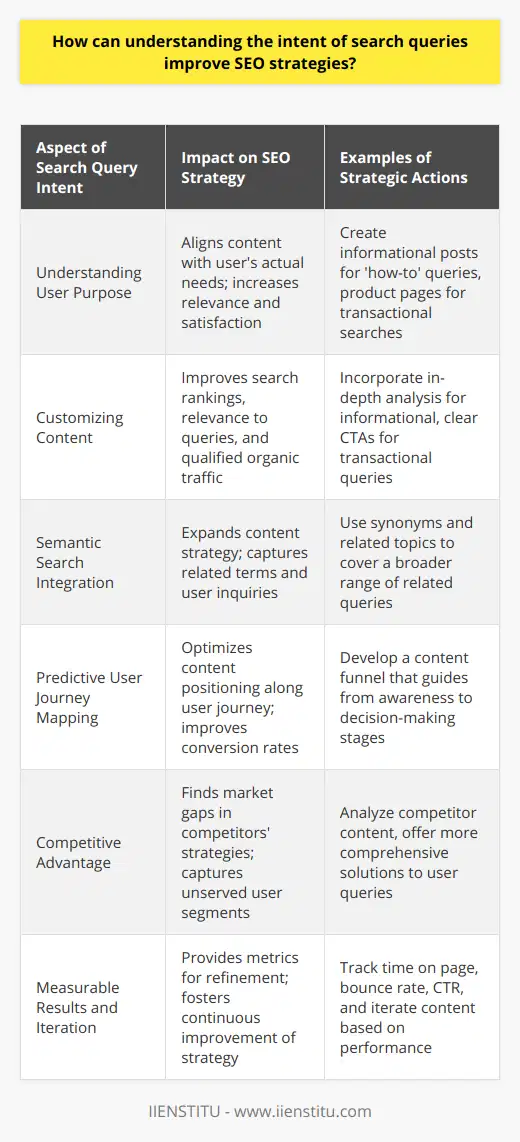
What role do context and related concepts play in semantic SEO?
Role of Context in Semantic SEO
Context plays a crucial role in semantic SEO by enabling search engines to comprehend content beyond just keywords. It allows them to grasp the intent and meaning behind the words and phrases, ensuring that queries receive more relevant and accurate results. This is achieved through natural language processing (NLP), machine learning, and other advanced techniques that aid in understanding the underlying structures and connections within content.
Expanding the Scope of Keywords
A significant aspect of semantic SEO is the shift from exact-match keywords to related concepts, enabling search engines to consider synonymous or semantically related terms. This broadens the potential reach and visibility of content, as it can now rank for a diverse range of queries that share the same intent, rather than just those containing specific terms. Additionally, this approach encourages the creation of richer, more informative content that focuses on user needs instead of mere keyword targeting.
Leveraging Structured Data
Structured data, or schema markup, is another vital element in semantic SEO. It allows webmasters to provide search engines with additional information about the content and its entities, facilitating better understanding and more precise categorizations. Utilizing structured data can enhance search engine result pages (SERPs) with rich snippets, such as images, ratings, or additional links, offering users valuable information at a glance and potentially increasing click-through rates.
Embracing Topic Clusters
Topic clusters, or content silos, involve organizing related content into interconnected groups that revolve around a central pillar or core topic. This structure provides search engines with a clear hierarchy and context, helping them recognize semantic relationships and relevance within the content. By employing topic clusters within a website, site owners not only create a user-friendly navigation experience but also enhance the perceived authority and depth on the subject matter.
In conclusion, context and related concepts are essential aspects of semantic SEO that work towards delivering more relevant search results to users. Through NLP, the use of related keywords, structured data, and topic clusters, search engines can better understand and index content, ultimately improving SERP visibility and user experience.

How do search engines incorporate semantic understanding to improve search results?
**Semantic Understanding in Search Engines**
Search engines have come a long way in understanding user intent and delivering relevant search results. Incorporating semantic understanding has played a significant role in this improvement. This incorporation involves understanding the meaning and relationship between words and phrases during the search process.
**Keyword Context and Relationships**
Understanding the context of keywords is a crucial element in semantic understanding. Search engines consider synonyms, abbreviations, and related terms to better grasp the user's query. By doing this, search engines can provide more accurate and relevant results. For instance, a search for 'camping gear' will also display results related to 'camping equipment' or 'outdoor gear.'
**Natural Language Processing**
Natural Language Processing (NLP) has enabled search engines to improve semantic understanding. NLP refers to the algorithms that analyze human language and derive meaning from it. Search engines use NLP to determine query intent, disambiguate words with multiple meanings, and recognize relationships between words. This technology allows search engines to comprehend search queries as humans would and provide appropriate results more efficiently.
**Knowledge Graphs**
Another vital component in semantic understanding is the use of knowledge graphs. These graphs are massive databases that store information about entities, such as people, places, and things, and the relationships between them. Search engines use these graphs to find connections between the user's query and the relevant information stored in the graph. This approach helps provide tailored results based on the user's intent and context.
**Semantic Search and Machine Learning**
Machine learning has contributed significantly to improving the semantic understanding of search engines. Using algorithms, search engines can learn from user behavior and automatically refine their understanding of words and phrases. By analyzing patterns and trends, search engines can develop a richer understanding of context and intent over time. This continuous learning and adaptation lead to better and more accurate search results.
In conclusion, search engines have incorporated semantic understanding through various techniques, including keyword context analysis, natural language processing, knowledge graphs, and machine learning. These developments have significantly improved the relevance and accuracy of search results, satisfying users' needs while looking for information online.
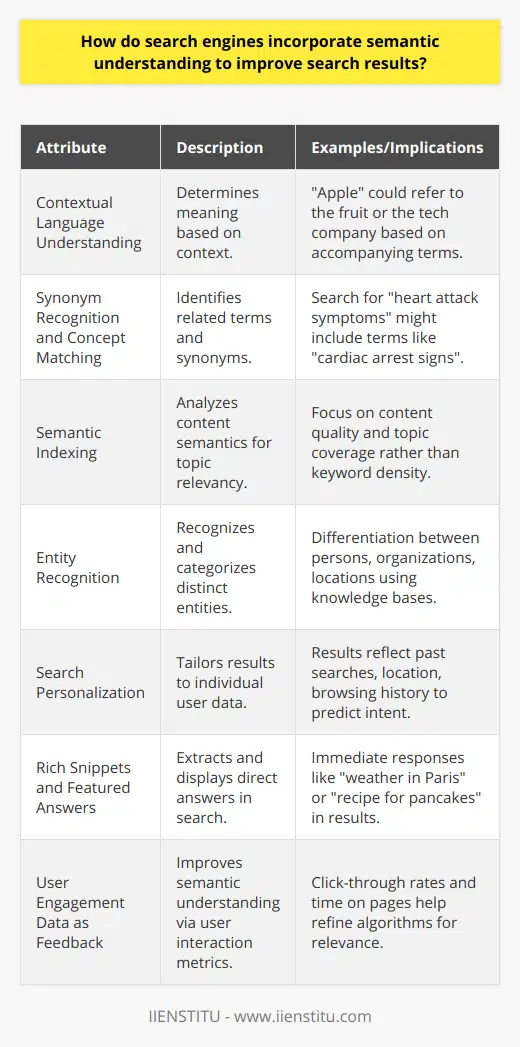
Can implementing semantic SEO improve a website's overall search ranking?
Subheading: Semantic SEO and SERP
Implementing semantic SEO can significantly improve a website's overall search ranking. Semantic SEO aims to understand users' intentions behind their search queries, providing relevant and accurate content that satisfies their needs.
Subheading: Latent Semantic Indexing
One way to achieve semantic SEO is through Latent Semantic Indexing (LSI), which allows search engines to correlate terms and phrases. By incorporating LSI keywords, websites can effectively optimize content, enhance topic relevance, and increase page rankings on search engine result pages (SERPs).
Subheading: Topical Authority
Semantic SEO also addresses the concept of topical authority. Websites that consistently produce high-quality content within a specific field are viewed as more credible and reliable sources. Search engines prioritize these sites, leading to improved search rankings for content with topical authority.
Subheading: Improved User Experience
Incorporating semantic SEO enhances the user experience on a website. By understanding their search intent, websites can offer users tailored content that fulfills their needs. This customized approach enhances user satisfaction, which, in turn, reduces bounce rates and ultimately boosts search rankings.
Subheading: Structured Data
Implementing structured data in semantic SEO allows search engines to better understand the information on a website. Structured data, also known as schema markup, helps search engines comprehend and categorize website content. This clarity increases the likelihood of a website appearing in rich snippets or Google's Knowledge Graph, thereby improving the search ranking.
Subheading: Conclusion
In conclusion, implementing semantic SEO is a powerful approach for improving a website's overall search ranking. By adopting semantic techniques such as LSI, topical authority, enhanced user experience, and structured data, websites can provide users with a more relevant, valuable, and satisfying online experience. This, in turn, leads to improved search rankings and greater online visibility.
